Abstract
The effects of morphine on intraluminal pressures recorded from the sphincter of Oddi (SO) at endoscopic retrograde cholangiopancreatography in 19 patients who were without evidence of biliary or pancreatic disease were studied. Morphine was given in four successive doses of 2.5, 2.5, 5, and 10 micrograms/kg iv at five minute intervals. Morphine in subanalgesic doses increased the frequency of SO phasic pressure waves to a maximum of 10-12/min, caused the phasic waves to occur simultaneously along the sphincter segment, increased phasic wave amplitude from 72 (26) (SE) to 136 (31) mmHg, and increased SO basal pressure from 10 (1) to 29 (9) mmHg (p less than 0.05). The effects of morphine on the SO are mediated by more than one opioid receptor type, as naloxone competitively antagonised the increase in phasic wave frequency induced by morphine, but did not affect the increase in SO basal pressure elicited by morphine. When given after naloxone, morphine decreased phasic wave amplitude, an inhibitory effect that is normally masked by morphine's dominant naloxone sensitive excitatory effect. Mu receptors do not appear to be involved in control of spontaneous SO motor function, as naloxone alone did not affect SO motor activity. The excitatory effects of morphine on the SO are not mediated by cholinergic nerves, as they were not blocked by atropine. Cholinergic nerves, however, may have a role in regulating spontaneous SO motor function because atropine alone depressed phasic wave activity and basal pressure. Although morphine does cause 'spasm' of the human SO, its effects are more complex than is commonly believed.
Full text
PDF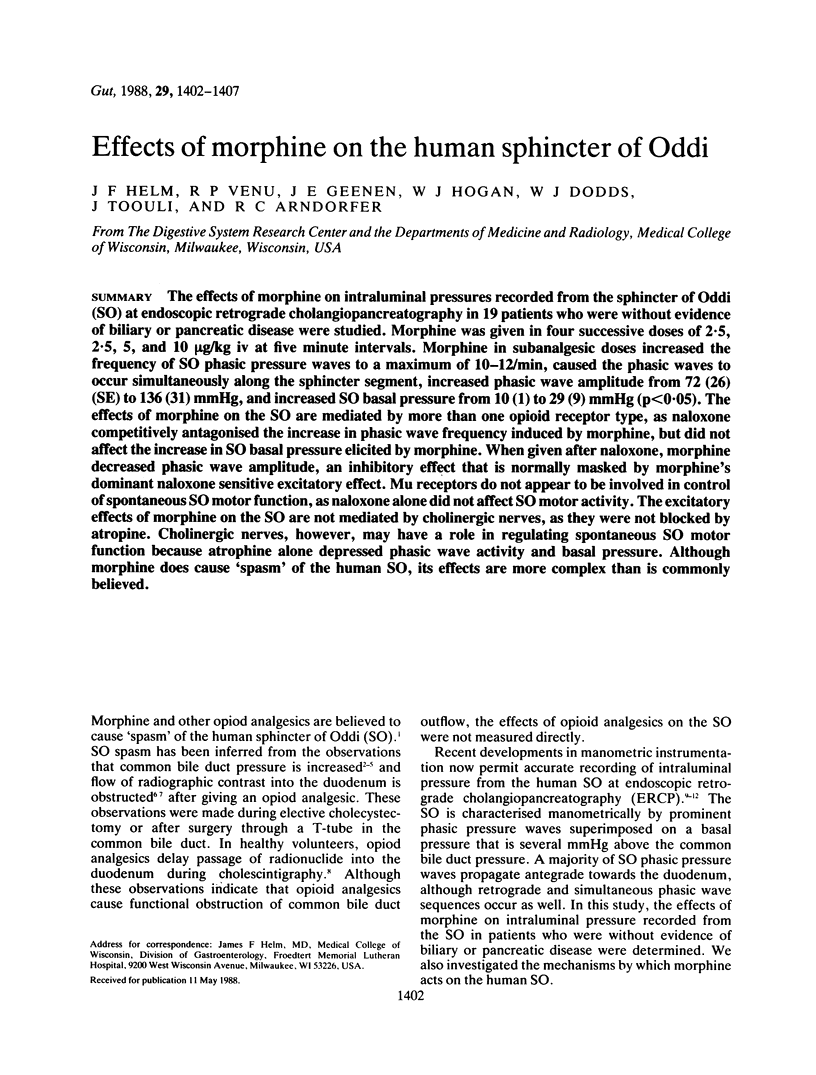
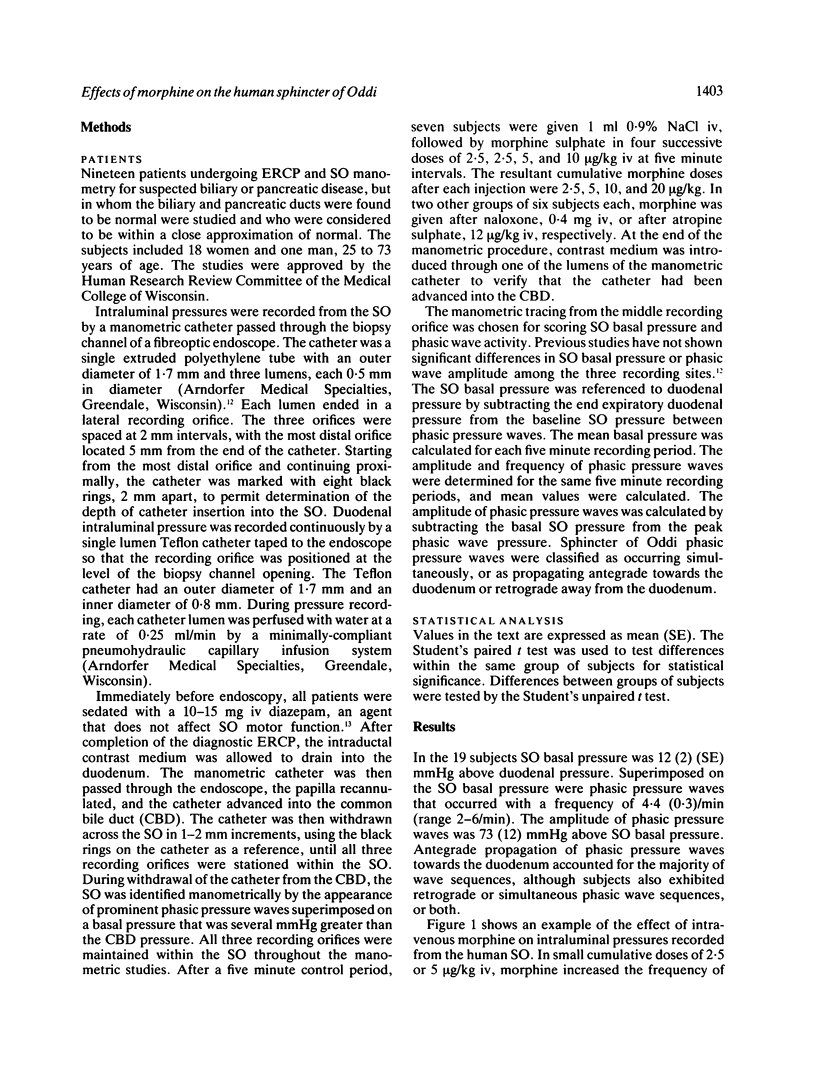
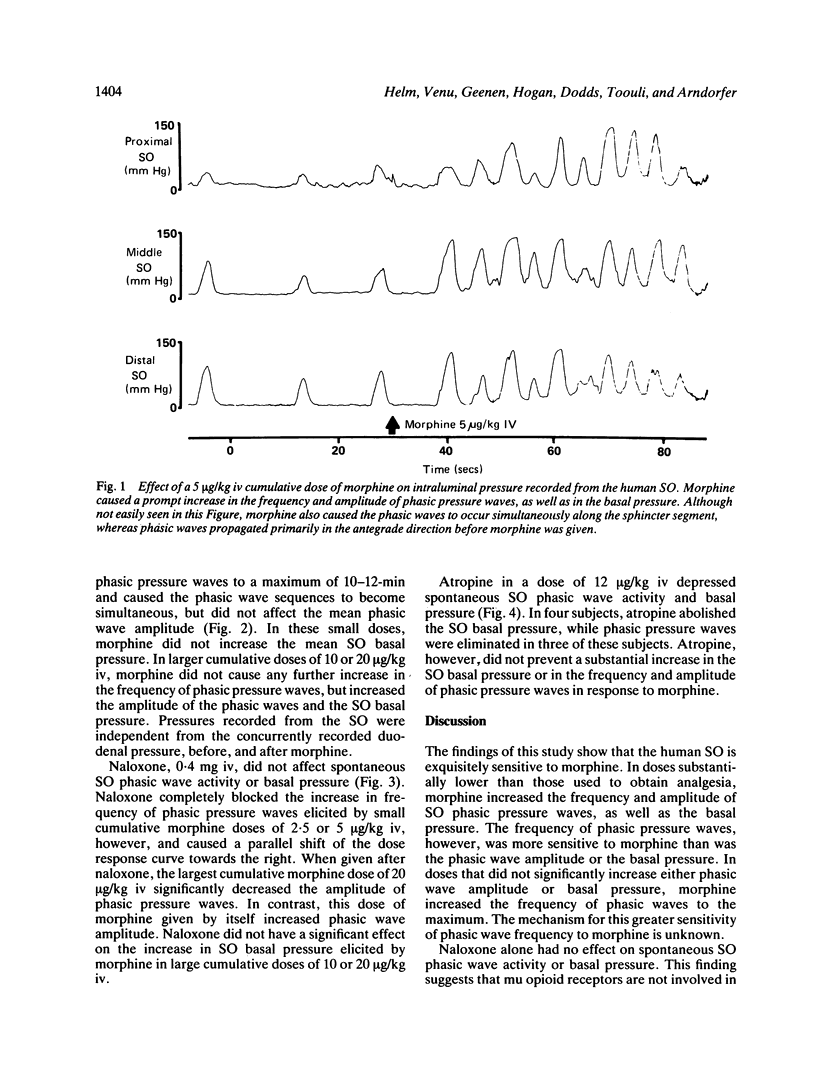
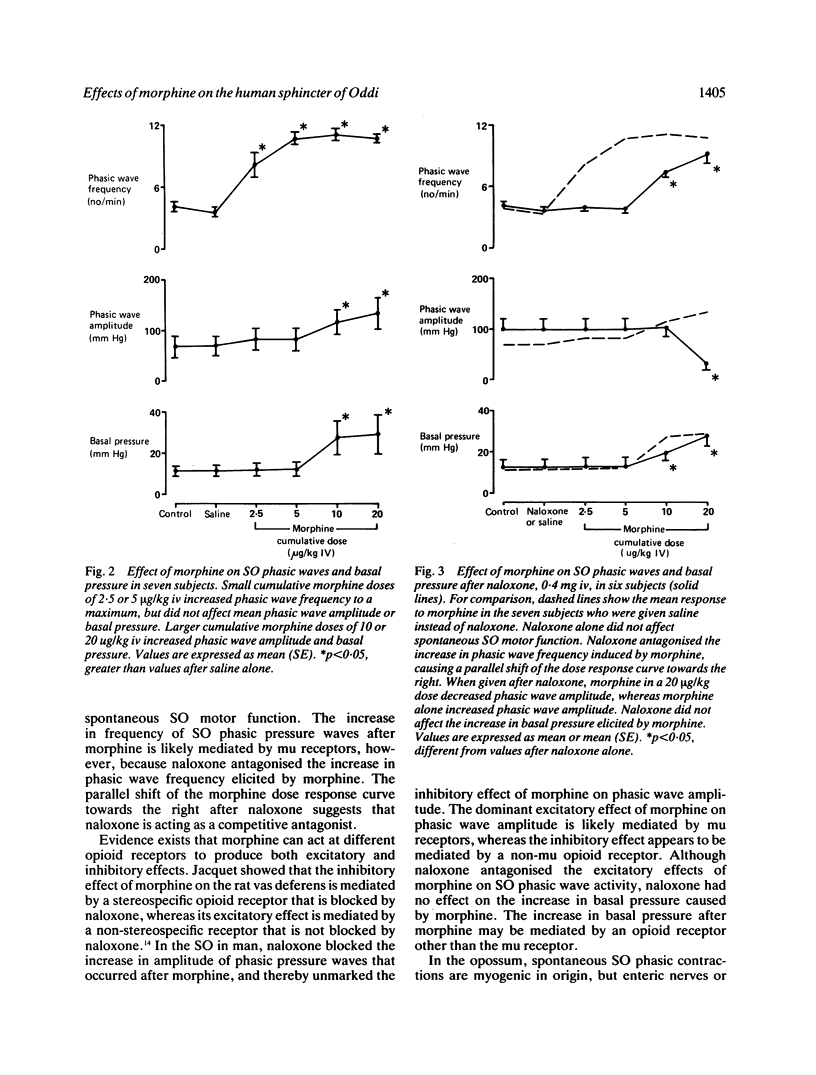
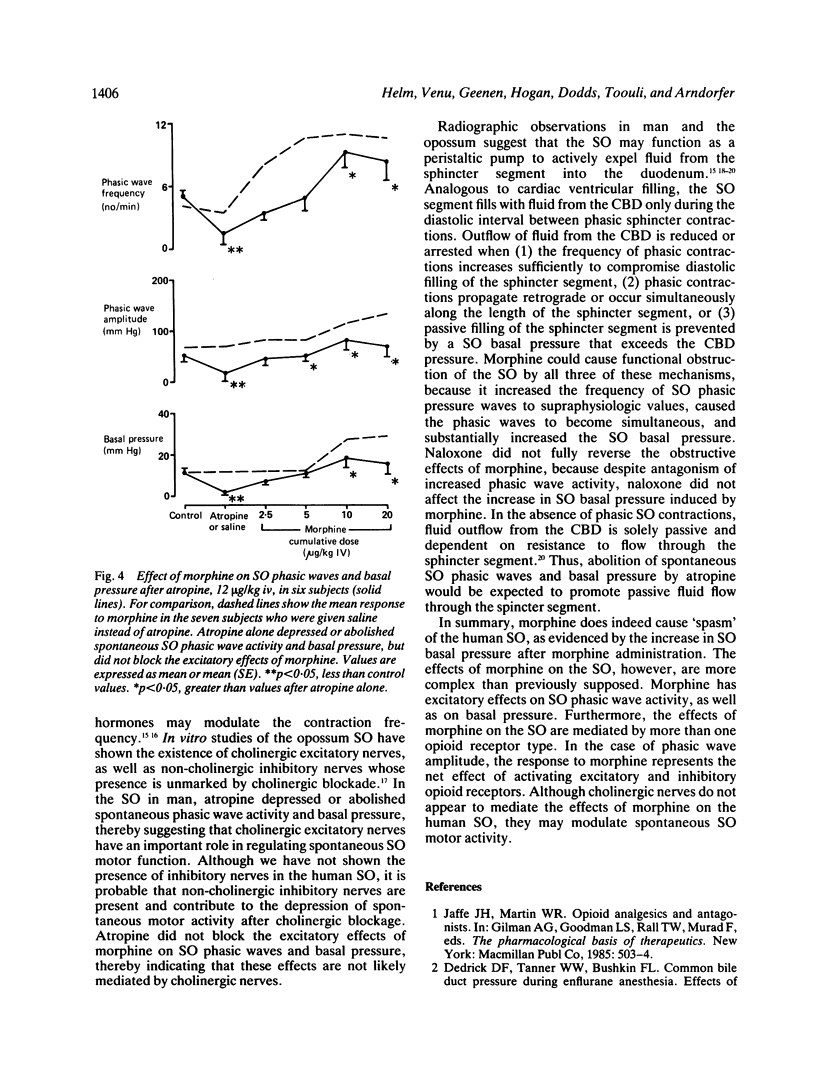
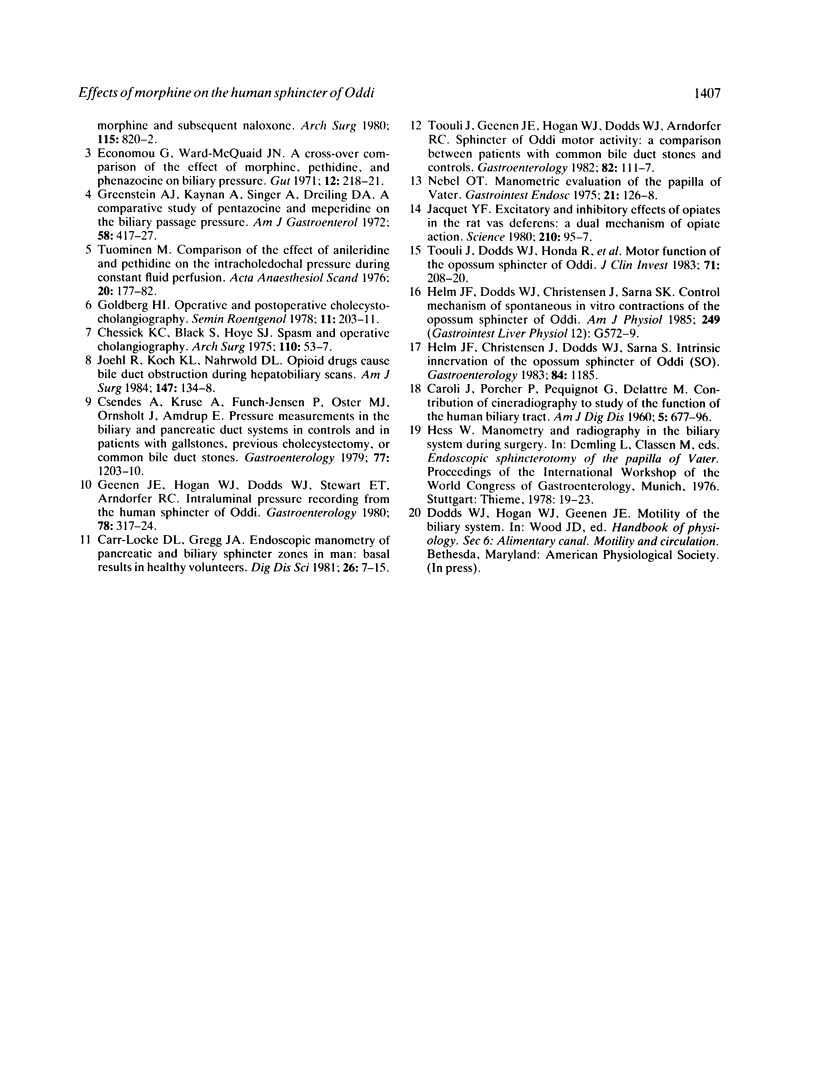
Selected References
These references are in PubMed. This may not be the complete list of references from this article.
- Carr-Locke D. L., Gregg J. A. Endoscopic manometry of pancreatic and biliary sphincter zones in man. Basal results in healthy volunteers. Dig Dis Sci. 1981 Jan;26(1):7–15. doi: 10.1007/BF01307970. [DOI] [PubMed] [Google Scholar]
- Chessick K. C., Black S., Hoye S. J. Spasm and operative cholangiography. Arch Surg. 1975 Jan;110(1):53–57. doi: 10.1001/archsurg.1975.01360070053009. [DOI] [PubMed] [Google Scholar]
- Csendes A., Kruse A., Funch-Jensen P., Oster M. J., Ornsholt J., Amdrup E. Pressure measurements in the biliary and pancreatic duct systems in controls and in patients with gallstones, previous cholecystectomy, or common bile duct stones. Gastroenterology. 1979 Dec;77(6):1203–1210. [PubMed] [Google Scholar]
- Dedrick D. F., Tanner W. W., Bushkin F. L. Common bile duct pressure during enflurane anesthesia. Effects of morphine and subsequent naloxone. Arch Surg. 1980 Jul;115(7):820–822. doi: 10.1001/archsurg.1980.01380070014003. [DOI] [PubMed] [Google Scholar]
- Economou G., Ward-McQuaid J. N. A cross-over comparison of the effect of morphine, pethidine, pentazocine, and phenazocine on biliary pressure. Gut. 1971 Mar;12(3):218–221. doi: 10.1136/gut.12.3.218. [DOI] [PMC free article] [PubMed] [Google Scholar]
- Geenen J. E., Hogan W. J., Dodds W. J., Stewart E. T., Arndorfer R. C. Intraluminal pressure recording from the human sphincter of Oddi. Gastroenterology. 1980 Feb;78(2):317–324. [PubMed] [Google Scholar]
- Goldberg H. I. Operative and postoperative cholecystocholangiography. Semin Roentgenol. 1976 Jul;11(3):203–211. doi: 10.1016/0037-198x(76)90052-3. [DOI] [PubMed] [Google Scholar]
- Greenstein A. J., Kaynan A., Singer A., Dreiling D. A. A comparative study of pentazocine and meperidine on the biliary passage pressure. Am J Gastroenterol. 1972 Oct;58(4):417–427. [PubMed] [Google Scholar]
- Helm J. F., Dodds W. J., Christensen J., Sarna S. K. Control mechanism of spontaneous in vitro contractions of the opossum sphincter of Oddi. Am J Physiol. 1985 Nov;249(5 Pt 1):G572–G579. doi: 10.1152/ajpgi.1985.249.5.G572. [DOI] [PubMed] [Google Scholar]
- Joehl R. J., Koch K. L., Nahrwold D. L. Opioid drugs cause bile duct obstruction during hepatobiliary scans. Am J Surg. 1984 Jan;147(1):134–138. doi: 10.1016/0002-9610(84)90047-3. [DOI] [PubMed] [Google Scholar]
- Nebel O. T. Manometric evaluation of the papillar of Vater. Gastrointest Endosc. 1975 Feb;21(3):126–128. doi: 10.1016/s0016-5107(75)73819-1. [DOI] [PubMed] [Google Scholar]
- Toouli J., Dodds W. J., Honda R., Sarna S., Hogan W. J., Komarowski R. A., Linehan J. H., Arndorfer R. C. Motor function of the opossum sphincter of Oddi. J Clin Invest. 1983 Feb;71(2):208–220. doi: 10.1172/JCI110761. [DOI] [PMC free article] [PubMed] [Google Scholar]
- Toouli J., Geenen J. E., Hogan W. J., Dodds W. J., Arndorfer R. C. Sphincter of Oddi motor activity: a comparison between patients with common bile duct stones and controls. Gastroenterology. 1982 Jan;82(1):111–117. [PubMed] [Google Scholar]
- Tuominen M. Comparison of the effect of anileridine and pethidine on the intracholedochal pressure during constant fluid perfusion. Acta Anaesthesiol Scand. 1976;20(2):177–182. doi: 10.1111/j.1399-6576.1976.tb05025.x. [DOI] [PubMed] [Google Scholar]


